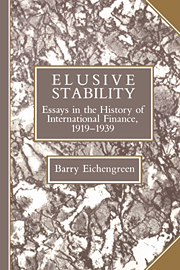Book contents
- Frontmatter
- Contents
- List of tables
- List of figures
- Acknowledgments
- 1 Introduction
- 2 Real exchange rate behavior under alternative international monetary regimes
- 3 Understanding 1921–1927: inflation and economic recovery in the 1920s
- 4 Bank Rate policy under the interwar gold standard
- 5 The Bank of France and the sterilization of gold, 1926–1932
- 6 International policy coordination in historical perspective: a view from the interwar years
- 7 The economic consequences of the franc Poincaré
- 8 Sterling and the tariff, 1929–1932
- 9 Exchange rates and economic recovery in the 1930s
- 10 The gold-exchange standard and the Great Depression
- 11 Hegemonic stability theories of the international monetary system
- References
- Index
3 - Understanding 1921–1927: inflation and economic recovery in the 1920s
Published online by Cambridge University Press: 21 March 2010
- Frontmatter
- Contents
- List of tables
- List of figures
- Acknowledgments
- 1 Introduction
- 2 Real exchange rate behavior under alternative international monetary regimes
- 3 Understanding 1921–1927: inflation and economic recovery in the 1920s
- 4 Bank Rate policy under the interwar gold standard
- 5 The Bank of France and the sterilization of gold, 1926–1932
- 6 International policy coordination in historical perspective: a view from the interwar years
- 7 The economic consequences of the franc Poincaré
- 8 Sterling and the tariff, 1929–1932
- 9 Exchange rates and economic recovery in the 1930s
- 10 The gold-exchange standard and the Great Depression
- 11 Hegemonic stability theories of the international monetary system
- References
- Index
Summary
The 1920s were for the industrial nations of the western world a decade of reconstruction and recovery. World War I had wrought destruction of two kinds of productive capacity: the physical capacity to produce goods and services, and the institutional capacity to mobilize productive resources and distribute the fruits of their labor. The first set of effects is more easily observed. Approximately 8.5 million soldiers, amounting to 15 percent of those mobilized, 2 percent of Europe's population, and nearly 8 percent of its adult male workers, died in active service. The number of casualties doubles when the permanently disabled are included and triples with the addition of civilian deaths. In parts of Europe, notably portions of France, Belgium, and northern Italy, where trench warfare had been waged, extensive destruction of industrial capacity had occurred. Restoring basic infrastructure, rebuilding plant and equipment, reconverting capacity from war-to peace-time uses, and training replacements for skilled workers proved to be a drawn-out process. The upward trend in industrial production over the first postwar decade is typically understood to reflect the gradual reconstruction of this type of productive capacity.
The impact of the war on economic institutions, while more difficult to quantify and measure, was equally profound. In the domestic sphere, wartime exigencies had undermined monetary stability, fiscal orthodoxy, and accepted standards of labor-management relations. In the international sphere, they had disrupted foreign trade, led to the gold standard's abandonment, and impeded the free international movement of capital.
- Type
- Chapter
- Information
- Elusive StabilityEssays in the History of International Finance, 1919–1939, pp. 24 - 56Publisher: Cambridge University PressPrint publication year: 1990
- 3
- Cited by



